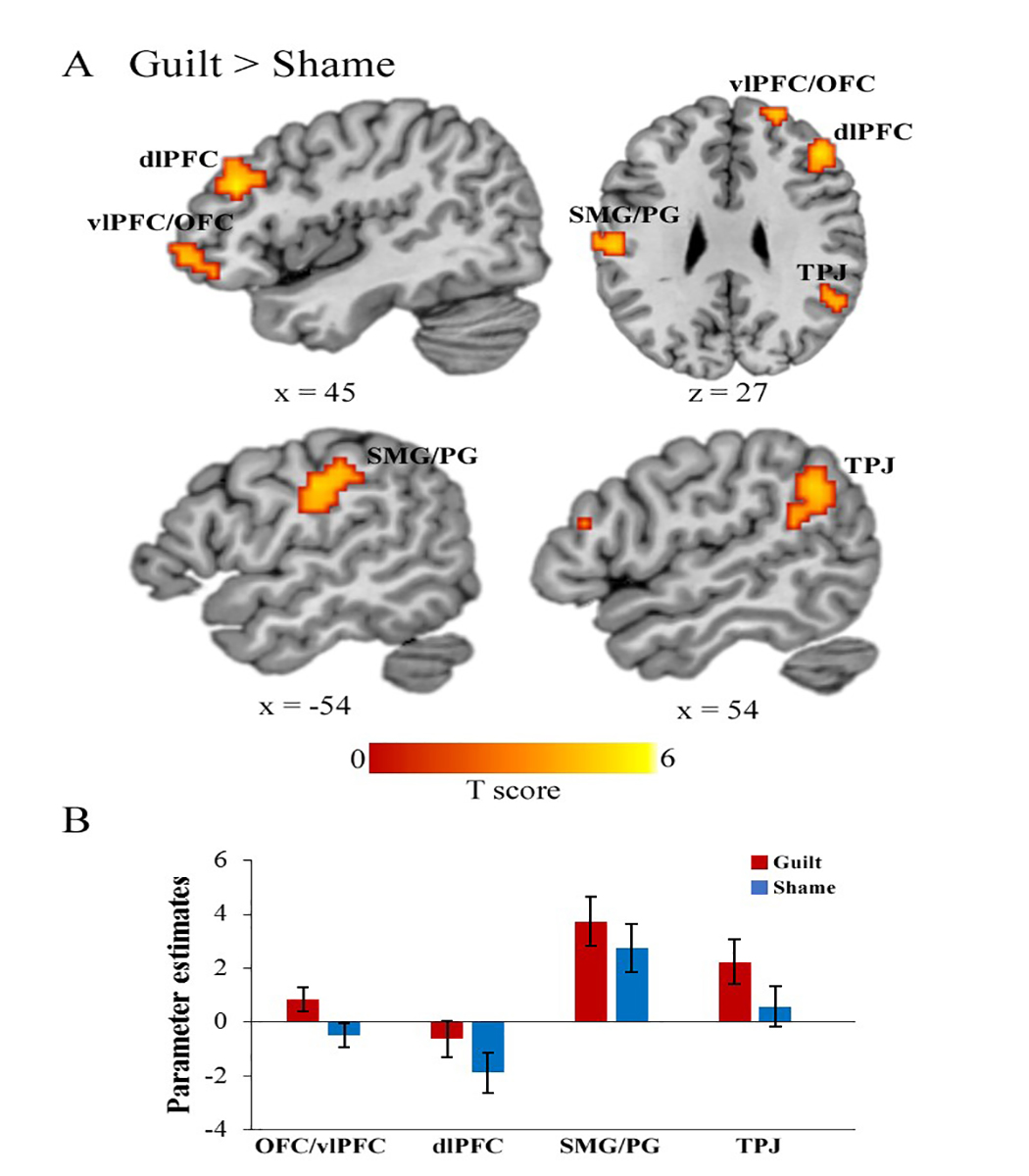Our group published a paper in NeuroImage revealing the neural mechanisims of guilt and shame
date: Nov 7, 2018
On November 7 , NeuroImage published our research article entitled “Differentiating Guilt and Shame in an Interpersonal Context with Univariate Activation and Multivariate Pattern Analyse”, the research article reveals the neural mechanisms of guilt and shame.
Guilt and shame, two typical moral emotions, often arise when social norms are violated. In spite of those similarities, guilt and shame are also believed to be conceptually and theoretically different, In guilt, transgressors focus on what they did to others and condemn their own immoral behavior (Tangney & Dearing, 2003) ; However, findings that guilt (but not shame) facilitates relationship-reparation behaviors such as apology, compensation, and self-punishment, and no study showed that guilt promotes individuals to feel the victims’feelings. (Yu, Hu, Hu, & Zhou, 2014; Zhu, Jin, et al., 2017; Zhu, Shen, et al., 2017) . Compared with guilt, shame involves more self-oriented concerns about one’s own negative image (Tangney & Dearing, 2003) , which causes image-reparation behaviors such as withdrawal, hiding(avoiding be directly criticized)and improvement of themselves. Long-term and frequent shame experience was positively correlated with depression, anxiety and aggressive impulse (e.g. Zhu et al., 2018) .
There are researchers used the imagination and recall paradigms to explore the neural mechanisms of guilt and shame (Michl et al., 2014; Wagner, N’Diaye, Ethofer, & Vuilleumier, 2011) . There are some limitations in previous researches. As for the paradigms, the psychological processes of both imagination and recall are not necessary for guilt and shame (Bastin et al., 2016; Yu et al., 2014) . The imagination and recall paradigms may casue some brain activations related to imagination and recall processing themselves rather than guilt and shame processing, and the ecological validity is low. As for the analysis methods, previous studies merely used traditional univariate activation analysis to examine the neural correlates of guilt and shame. The univariate activation analysis, which is not as sensitive as other methods, such as multivariate pattern analysis (MVPA) , may be unable to detect subtledifferences between guilt and shame.
Concerning the limitations above, we developed a novel paradigm to induce guilt and shame in an interpersonal context. It enabled participants to directly experience guilt and shame during social interactions, which excluded unrelated psychological processes the guilt condition compared to the shame condition produced significant activation in brain regions related to theory of mind (left supramarginal gyrus and right TPJ) . In addition, the regions related to cognitive control (right vlPFC/OFC and right dlPFC) were also activated. Shame condition compared to guilt condition revealed no significant results under the predetermined threshold.

figure1 Based on univariate activation analysis, brain activation in the comparison between guilt and shame conditions.
A) showed the significant activation B)showed the parameter estimation
MVPA showed that regions distinguishing guilt and shame were related to theory of mind (TPJ) and cognitive control (vlPFC and dlPFC). Importantly, MVPA additionally found that the multivariate neural patterns of the dmPFC and vACC, which revealed no significant regional-average activation differences in the contrast between guilt and shame, could distinguish guilt and shame.

figure2 The results based on univariate activation analysis
We showed that guilt relative to shame induced more activation in the regions related to theory of mind (supramarginal gyrus and TPJ) and cognitive control; MVPA also found differential neural patterns of the dmPFC and vACC in response to guilt and shame, which indicates that the self-referential processing of guilt and shame might be different. Our findings shed light on the psychological and neural mechanisms of interpersonal guilt and shame, which provide insights on some socail behaviours and psychiatric disorders.
The first author of this article is Dr. Ruida Zhu, This work was supported by the National Key R&D Program of China (2017YFC0803402), the National Natural Science Foundation of China (NSFC) (31871094, 31771206).
Link of the article:
Zhu, R., Feng, C., Zhang, S., Mai, X., & Liu, C. (2018). Differentiating guilt and shame in an interpersonal context with univariate activation and multivariate pattern analyses. NeuroImage. [PDF]
References:
Michl, P., Meindl, T., Meister, F., Born, C., Engel, R. R., Reiser, M., & Hennig-Fast, K. (2014). Neurobiological underpinnings of shame and guilt: A pilot fMRI study. Social Cognitive and Affective Neuroscience, 9, 150–157.
Tangney, J. P., & Dearing, R. L. (2003). Shame and guilt. New York: Guilford Press.
Wagner, U., N’Diaye, K., Ethofer, T., & Vuilleumier, P. (2011). Guilt-Specific Processing in the Prefrontal Cortex. Cerebral Cortex, 21, 2461–2470.
Yu, H., Hu, J., Hu, L., & Zhou, X. (2014). The voice of conscience: neural bases of interpersonal guilt and compensation. Social Cognitive and Affective Neuroscience, 9, 1150–1158.
Zhu, R., Jin, T., Shen, X., Zhang, S., Mai, X., & Liu, C. (2017). Relational utility affects self-punishment in direct and indirect reciprocity situations. Social Psychology, 48, 19–27.
Zhu, R., Shen, X., Tang, H., Ye, P., Wang, H., Mai, X., & Liu, C. (2017). Self-Punishment Promotes Forgiveness in the Direct and Indirect Reciprocity Contexts. Psychological Reports, 120, 408.
Zhu, R., Xu, Z., Tang, H., Liu, J., Wang, H., An, Y., … Liu, C. (2018). The effect of shame on anger at others: awareness of the emotion-causing events matters. Cognition and Emotion, 1–13.

